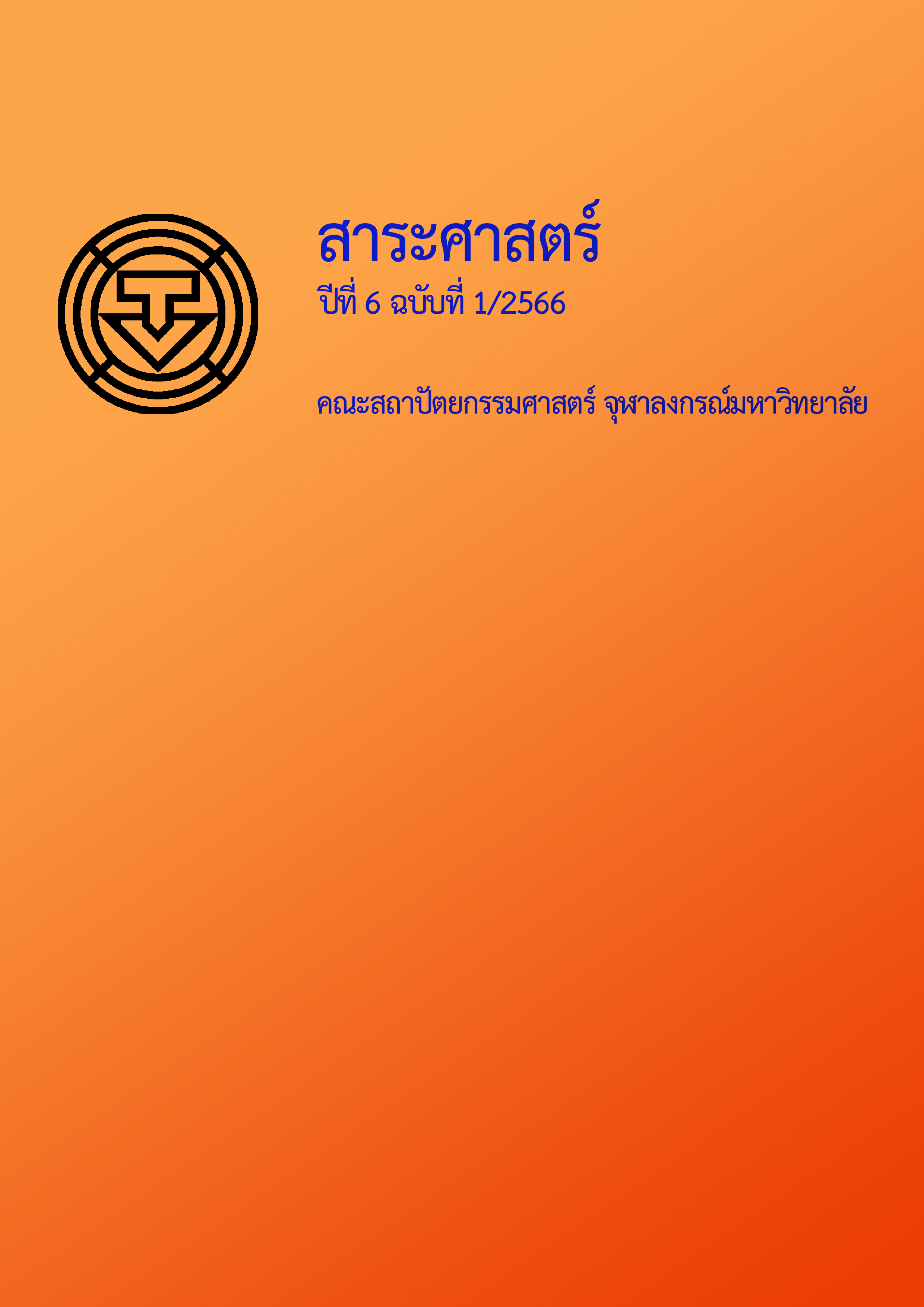Development of Building Information Modeling (BIM) to Calculate the Circadian Lighting for Office Spaces at Schematic Design Stage
Main Article Content
Abstract
Daylight is an important factor affecting the body's sleep-wake cycles (Circadian rhythm). When combined with artificial light in an appropriate ratio, it improves the quality of the indoor environment and the well-being of employees. The objective of the research was to study the method of calculating the amount of light that affects the biological clock, to develop a Building Information Modeling (BIM) tool to facilitate the calculation for designers by using Autodesk Revit (Revit) and an add-on tool: Dynamo Studio (Dynamo).
The tool development process consists of 3 steps: Determining the melanopic ratio (MR) of natural light in Thailand to get the equivalent melanopic lux: EML value, studying the working process of BIM, to set the important fundamental data for developing the tools, and comparing the results of the developed tools with those of other programs. The results show that the developed tools can help in calculating the vertical illuminance (Ev) to achieve the desired EML value under both natural and artificial lighting. Thus, architects can design transparent building envelopes with the efficient use of artificial lighting in office buildings to improve the quality of the circadian rhythm of the human body.
Article Details
References
จิณห์วรา อรัณย์ชนายุธ และอวิรุทธ์ ศรีสุธาพรรณ. (2562). แนวทางการใช้แสงธรรมชาติให้เหมาะสมกับนาฬิกาชีวิต สำหรับอาคารสำนักงาน. 10th Built Environment Research Associates Conference, BERAC2019, 10(25), 52-59.
จิณห์วรา อรัณย์ชนายุธ และอวิรุทธ์ ศรีสุธาพรรณ. (2564). แนวทางการใช้เกณฑ์การประเมินแสงธรรมชาติที่มีผลต่อนาฬิกาชีวิตในประเทศไทย. Journal of Architectural/Planning Research and Studies JARS, 18(1), 115-130.
ปวริศร์ คำมุลตรี และวรภัทร์ อิงคโรจน์ฤทธิ์. (2563). การพัฒนาโปรแกรมเสริมบนแบบจำลองสารสนเทศอาคาร เพื่อช่วยในการประเมินประสิทธิภาพการใช้พื้นที่อาคารเรียนในมหาวิทยาลัย. วารสารสิ่งแวดล้อมสรรค์สร้างวินิจฉัย คณะสถาปัตยกรรมศาสตร์ มหาวิทยาลัยขอนแก่น, 10(1), 99-118.
ภัทรพล วัชรเมธากุล และอรรจน์ เศรษฐบุตร. (2563). การพัฒนาเครื่องมือเสริมบนแบบจำลองสารสนเทศอาคารเพื่อการคำนวณปริมาณน้ำฝนไหลหลากในขั้นตอนการออกแบบขั้นต้น. สาระศาสตร์, 3(4), 881-894.
ศรุดา จิรัฐกุลธนา. (2563). แสงสว่างและพฤติกรรมของมนุษย์. PSRU Journal of Science and Technology, 5(1), 13- 22.
สมาคมสถาปนิกสยาม ในพระบรมราชูปถัมภ์. (2558). คู่มือปฏิบัติวิชาชีพ แนวทางการใช้งานแบบจำลองสารสนเทศอาคารสำหรับประเทศไทย (Thailand BIM Guideline).
อรพินทร์ เชียงปิ๋ว. (2555). นาฬิกาชีวภาพกับการนอนหลับ. วารสารมหาวิทยาลัยศรีนครินทรวิโรฒ (สาขาวิทยาศาสตร์และเทคโนโลยี), 4(7), 145-155.
อวิรุทธ์ ศรีสุธาพรรณ. (2563). แนวทางและการประยุกต์ใช้ตัวชี้วัดแสงธรรมชาติสำหรับอาคารในประเทศไทย. Journal of Architectural/Planning Research and Studies (JARS), 17(1), 103-120.
อวิรุทธ์ ศรีสุธาพรรณ. (2565). การศึกษาการออกแบบร่วมกันระหว่างการวิเคราะห์แสงธรรมชาติแบบรายปีตามสภาพภูมิอากาศและการออกแบบแสงเพื่อนาฬิกาชีวภาพ. Journal of Architectural/Planning Research and Studies (JARS), 19(1), 21-40.
Acosta, I., Campano, M. A., Molina, J., & Fernández-Aguera, J. (2019). Analysis of visual comfort and circadian stimulus provided by window design in educational space. International Journal of Engineering and Technology, 11(2), 105-110.
Borisuit, A. (2013). The impact of light including non-image forming effects on visual comfort [Unpublished doctoral dissertation]. École Polytechnique Fédérale de Lausanne (EPFL).
Figueiro, M. G., Gonzales, K., & PedLer, D. (2016). Designing with circadian stimulus. Ld+ a, 8, 30-34.
Hagen, E., & Richardson, H. (2016). Circadian daylight in practice, determining a simulation method for the design process. In Douglas Noble, Karen Kensek, & Shreya Das (Eds.), Facade tectonics: Vol. 2. World Congress Los Angeles 2016 Conference Proceedings (pp. 51-57). Tectonic Press.
Hengrasmee, N. (2019). Circadian lighting design criteria for health and well-being in Thai built environment [Unpublished doctoral dissertation]. Naresuan University.
International WELL Building Institute. (2022). The WELL building standard version 2. https://standard.wellcertified.com/v7/tables
Littlefair, P., & Ticleanu, C. (2019). Lighting for circadian rhythms. BRE Trust.
Lucas, R. J., Peirson, S. N., Berson, D. M., Brown, T. M., Cooper, H. M., Czeisler, C. A., Figueiro, M. G., Gamlin, P. D., Lockley, S. W., & O’Hagan, J. B. (2014). Measuring and using light in the melanopsin age. Trends in neurosciences, 37(1), 1-9.
Sahebghalam, S. (2021). Assessment of the circadian stimulus potential in a daylit classroom: A simulation-based evaluation of key factor to enhance daylight-driven circadian lighting [Unpublished doctoral dissertation]. Kent State University.
Sánchez-Cano, A., & Aporta, J. (2020). Optimization of lighting projects including photopic and circadian criteria: A simplified action protocol. Applied Sciences, 10(22), 8068.
Zielinska-Dabkowska, K., & Xavia, K. (2018). An overview of the cognitive and biological effects of city nighttime illumination including a London case study. Conscious Cities Anthology 2018: Human- Centred Design, Science, and Technology, 1-9.


